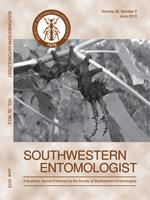The agave weevil, Scyphophorus acupunctatus Gyllenhal (Coleoptera: Curculionidae), causes economic damage to Agave tequilana F.A.C Weber var. ‘Blue’, A. fourcroydes Lem., A. angustifolia Haw, and Polianthes tuberosa Lem. Currently, the synthetic compound 2-methyl-4-octanone is used to monitor S. acupunctatus, but factors involved in chemical communication by S. acupunctatus need to be better understood. We used electroantennography, olfactometer bioassays, and analysis of the COI mitochondrial region to study the effect of sex, age, and genetic structure on the electrophysiological response and search behavior by S. acupunctatus to 2-methyl-4-octanone. We showed that electrophysiological and behavioral response to 2-methyl-4-octanone differed among populations of agave weevils from different crops and geographical regions. Furthermore, it was determined that the age of the insect was involved in both responses. Also, genetic changes in mitochondrial DNA suggest groups that differ in their response of S. acupunctatus to 2-methyl-4-octanone. This information provides a baseline to design a method to control agave weevil based on geographical region and type of host.
How to translate text using browser tools
1 June 2013
Factors in the Response of Agave Weevil, Scyphophorus acupunctatus (Coleoptera: Curculionidae), to the Major Compound in its Aggregation Pheromone
Ausencio Azuara-Domínguez,
Juan Cibrián-Tovar,
Antonio P. Terán-Vargas,
Obdulia L. Segura-León,
Angélica Cibrián-Jaramillo
ACCESS THE FULL ARTICLE

Southwestern Entomologist
Vol. 38 • No. 2
June 2013
Vol. 38 • No. 2
June 2013




